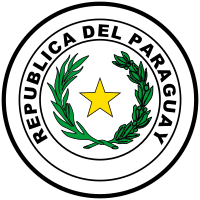Armed Forces of Paraguay
The Armed forces of Paraguay (Spanish: Fuerzas Armadas de Paraguay) consist of the Paraguayan army, navy (including naval aviation and marine corps) and air force.
| Armed Forces of Paraguay | |
|---|---|
| Fuerzas Armadas de Paraguay | |
| Service branches | Paraguayan Army Paraguayan Air Force Paraguayan Navy |
| Leadership | |
| Commander-in-chief | Mario Abdo Benítez |
| Minister of Defense | Diogenes Martínez |
| Commander of the Armed Forces | General of the Army Luis Gonzaga Garcete Espinola |
| Manpower | |
| Military age | 18 |
| Available for military service | 1,678,335[1], age 16–49 (2010 est.) |
| Fit for military service | 1,409,859, age 16–49 (2010 est.) |
| Reaching military age annually | 73,367 (2010 est.) |
| Active personnel | 15,650 active military (2016)[2] 14,800 paramilitary (2012)[2] |
| Reserve personnel | 168,500 (2012)[2] |
| Expenditures | |
| Budget | $US 248 million (2011)[2] |
| Percent of GDP | 1.66%[1] |
| Industry | |
| Foreign suppliers | |
| Related articles | |
| Ranks | Military ranks of Paraguay |
The constitution of Paraguay establishes the president of Paraguay as the commander-in-chief.
Paraguay has compulsory military service, and all 18-year-old males and 17-year-olds in the year of their 18th birthday are liable for one year of active duty. Although the 1992 constitution allows for conscientious objection, no enabling legislation has yet been approved.
In July 2005, military aid in the form of U.S. Special Forces began arriving at Paraguay's Mariscal Estigarribia air base, a sprawling complex built in 1982.[3][4]
Army
In land forces the Paraguayan Army is composed of a Presidential Guards Regiment, composed two battalions (infantry and military police), an armored squadron, and a battery of field artillery, plus the operationally attached Mounted Ceremonial Squadron "Aca Caraya" (which serves independently but as the mounted escort in state events, and serves as part of the 4th Cavalry Regiment). Their equipment includes three Argentinean modified M-4 tanks, four EE-9 armored cars, four EE-11 armored personnel carriers (APCs), three M-9 half-tracks mounting 20mm guns, and four M-101 105 mm howitzers. Arguably, this "flagship" of military rule is structurally and physically the strongest of the EP. The REP is an independent unit from other commands. The EP features two artillery groups (GAC 1–12 88 mm QF-25 and GAC 2–12 105mm M-101) and one antiaircraft artillery group (GAA 13 40 mm L 40/60, Oerlikon 20 mm cannons, and six M-55 4x12, 7.0 mm).
Six battalions of combat engineers, one communications battalion, one Special Forces battalion, seven regiments of infantry, six regiments of cavalry (R.C.-2 equipped with 12 M3A1, five operational, 20 M9 half-tracks modernized and R.C.-3: 24 EE-9 Cascavels, eight EE-11 Urutu APCs plus utility trucks for motorized infantry). This has little organic aviation available to it.
Each corps has a weapons school run by its command. The logistical command manages 10 addresses materials, mobilization, health care, etc. The command of the Army Institute of Education administers three schools, commissioned and noncommissioned officers, a military academy, and the CIMEFOR (a center for pre-military study that trains Reserve officers).
Each of the nine divisions that make up the three corps has one or two regiments of infantry or cavalry, its platoon of engineers, its communications section, military police units, etc.
Navy

Although Paraguay is a landlocked country, it has a strong naval tradition by virtue of the fact that it has access to the Atlantic Ocean through the Paraguay–Paraná rivers. The Paraguayan Navy has twelve bases. The main base is the Puerto Sajonia in Asuncion, followed by Bahia Negra, Ciudad del Este, Encarnacion, Salto del Guaira. It also has facilities in Puerto Sajonia for helicopters and airplanes in SGAS. Naval personnel including Marine Corps aviation personnel, and the naval inward waters prefecture equal about 8,950. The Marine Corps have 800 marines, of which 400 are assigned to one commando unit with the rest being organized into a single battalion consisting of three companies.
In terms of vessels, the Navy has 34 surface ships, some of which have reached centenarian age. (This is due in part to limited use and floating in fresh water.) The main vessels and the flagship of the Paraguay Navy is still Humaita, which was commissioned prior to Paraguay's involvement in the Chaco War. It has a further four patrol vessels, of which the oldest was commissioned in 1908 and the newest in 1985. The Navy has 17 patrol boats of various drafts, four of which were donated by Taiwan and the United States, while the other 13 were built locally. The rest of the fleet is composed of tugboats, barges, landing craft, transports, and a presidential yacht. The new additions are four Croc-class riverine vessels from Australia, plus 43 locally built riverline patrol vessels constructed from 2006–2009.
Order of battle
COMANFLOT: Comando de la Flota de Guerra.(Fleet Forces Command)
COMIM: Comando de Infantería de Marina.(Fleet Marine Command)
- Marine Forces Regiment
- BIM 1 - Rosario
- BIM 2 - Vallemi
- BIM 3 - Carapegua
- Marine Commando Battalion
- COMAVAN(Naval Aviation Command)
Grupo Aeronaval de Helicópteros (GAHE), Sajonia
Escuadrilla de Helicópteros de Ataque (EHA)
Escuadrilla de Propósitos Generales (EPG)
Grupo Aeronaval de Propósitos Generales (GAPROGEN)
Grupo Aeronaval de Entrenamiento (GAEN)
- COAPCOM: Comando de Apoyo al Combate.(Combat Support Command)
- CINAE: Comando de Institutos Navales y Enseñanza(Naval Education and Training Command)
- PGN: Prefectura General Naval.(General Naval Prefecture)
Cuartel General (Command)
Estado Mayor (HQ)
Prefectura Zona Pilar (Pilar Naval Prefecture)
Prefectura Zona Alberdi (Alberdi Naval Prefecture)
Prefectura Zona Central (Central Naval Prefecture)
Prefectura Zona Concepcion (Cencepcion Naval Prefecture)
Prefectura Zona Olimpo (Olimpo Naval Prefecture)
- DIRMAT: Dirección del Material (Material Directorate)
- DIAPSER: Dirección de Apoyo al Servicio (Service Support Directorate)
Naval aviation
| Aircraft | Origin | Type | Version | In service | Notes | |
|---|---|---|---|---|---|---|
| Helicopters | ||||||
| Helibras HB350 | Brazil | utility / SAR | HB350B | 1[5] | ||
Air Force
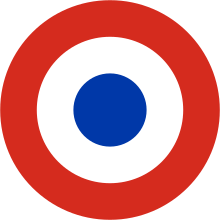
The air force, the newest and smallest of the services, has about 1,100 personnel as of 2012.[6] The Paraguayan Air Forces is organised in an Air Brigade of seven air groups and a brigade of paratroopers on battalion level. Almost all operating units are based in premises at Silvio Pettirosi internacional airport (SGAS) in Asuncion.
The units comprising the force are: the Aerotactico group (TAG) with three fighter squadrons (numbered 1 to 3), respectively equipped with the MB-326, T-33 and EMB-312. The first two are in storage or operating either by withdrawal of this aircraft. The squadron "Moros", equipped with Tucanos, has only one squadron (3 airplanes active). The Air Transport Group (GTA) operates aircraft of the CASA, DHC-6, and Beechcraft types. The Helicopter air group (HLG) has a SAR squadron, a utility squadron, and a squadron of attack craft, and is equipped with ex-Taiwanese UH-1H and Brazilian HB-350B aircraft. The Air Group Instruction (AFI) has materials and T-25 and T-35 aircraft. Photogrammetric called air group (GAF) and group aviation maintenance section (SEMAER) do not have aircraft assigned. The Parachute Brigade operates CASA aircraft. Paraguayan Helicopters constantly flew the skies of Asuncion during the visit of Pope Francis in July 2015
Besides these groups is a command of Institutes of Education and one of regions air, this latter has nominal jurisdiction over 12 tracks and airports as six of these are considered Air Bases.[7]
Order of battle
- 1º Brigada Aérea (Air Brigade; Asunción/Base Aérea Ñu Guazú)
- Grupo Aerotáctico (Air Tactical Group; Asunción/Base Aérea Pettirossi)
- 1º Escuadrón de Caza 'Guaraní' (Escuadrilla 'Orion' y 'Centauro'), no longer active
- 2º Escuadrón de Caza 'Indios' (Escuadrilla 'Taurus' y 'Scorpio'), no longer active
- 3º Escuadrón de Reconocimiento y Ataque 'Moros' (Reconnaissance and Attack Squadron; Escuadrilla 'Gamma' y 'Omega'): EMB-312
- Grupo Aéreo de Instrucción (Instrucción Air Group) 'Escuadrón Fenix': T-25A
- Escuadrilla 'Antares' / 'Pantera' / 'Halcón': T-35A/B
- Grupo de Transporte Aéreo(Transport Air Group) (Asunción/Base Aérea Pettirossi)
- Escuadrilla de Transporte aéreo: C-212 (Asuncion/Base Aérea Ñu Guazu)
- Escuadrilla Presidencial: DHC-6 (Asunción/Base Aérea Pettirossi)
- Grupo Aéreo de Helicópteros(Helicopters Air Group): UH-1H / HB-350 (Asunción/Base Aérea Ñu-Guanzu)
- Grupo Aéreo de Transporte Especial (Special Transport Air Group): CE u206, Ce 210N, Ce 402B, PA 32R, PZL 104 (Asunción/Base Aérea Ñu Guazu)
- Grupo Aéreo Fotogramétrico (GAF; Photogrammetric Air Group)
- Grupo Aéreo Mantenimiento (SEMAR; Maintenance Air Group)
- Brigada Aerotransportada "Silvio Pettirossi" (Airborne Brigade; Asunción/Base Aérea Ñu Guazu)
- Bat. Paracaid. (Paratroopper battalion)
- Bat. Apoy.Sev (Logisti battalion)
- Escu. Paracaid. (Paratrooper School)
- Bat. Inf. Aeromo. (Air mobile battalion)
- Bat.Securit. (Security Battalion)
- Comando de Regiones Aéreas
- Comando Reg. Or.
- Comando Reg. Oc.
- Direcc. Meteo.
- Brigada Logistica
- Unid. de Apoyo
- Unid. de Servicio
- Comando de Institutos Aeronauticos de Enseñanza (Concepción/Base Aérea de Peralta)
Aircraft
Current inventory
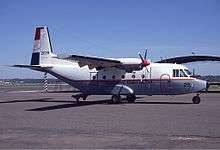
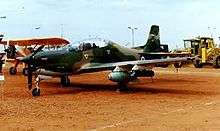
| Aircraft | Origin | Type | Variant | In service | Notes | |
|---|---|---|---|---|---|---|
| Combat aircraft | ||||||
| EMB 312 Tucano | Brazil | light attack / trainer | 6[5] | |||
| Transport aircraft | ||||||
| Cessna 208 | United States | transport | 2[5] | |||
| Cessna 402 | United States | transport | 1[5] | |||
| CASA C-212 | Spain | transport / medevac | 2[5] | |||
| Beechcraft Baron | United States | transport | 1[5] | |||
| Helicopters | ||||||
| Bell UH-1 | United States | utility | UH-1H | 10[5] | ||
| Helibras HB350 | Brazil | utility | 1[5] | |||
| Trainer aircraft | ||||||
| ENAER T-35 | Chile | basic trainer | 9[5] | |||
Retired
Previous aircraft operated by the Air Force consisted of the Lockheed T-33, MB-326, AT-6 Harvard, Douglas C-47 Skytrain, DHC-3 Otter, DHC-6 Twin Otter, Piper J-3 Cub, Cessna 185, Hiller UH-12, Bell H-13 Sioux, Morane-Saulnier MS.760 Paris, Fokker S-11, and the Aerotec T-23[8]
Military ranks
Officer ranks
The stars worn by Army and Air Force lieutenants (Sub-Teniente, Teniente, Teniente 1ro) and captains are silver in color. The ones worn by the Major, Lieutenant Colonel and Colonel are gold. The army officers branch is denoted by the color of circular pads under the stars, which is also the same color used for the chevron. Red denotes branches such as Infantry and Artillery, while Cavalry is denoted by a pink. A darker red denotes support branches such as Engineering Corps, Communications, and Intelligence. Green means Supply and Transportation, while purple is reserved for the Medicine Branch. Generals' special chevron consists of a woven depiction of the olive and palm found in the national emblem in gold threads.
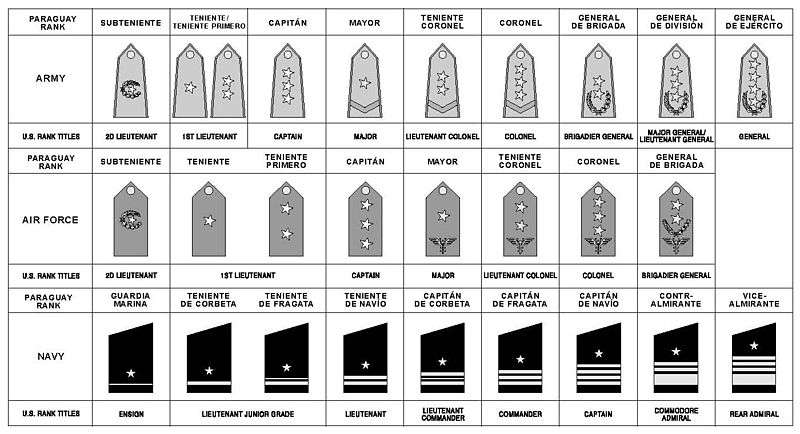
Enlisted ranks
As in the case of the army officers, the army enlisted branch is denoted by the color of their chevrons and bars. The colors and meanings are the same as the ones explained above.
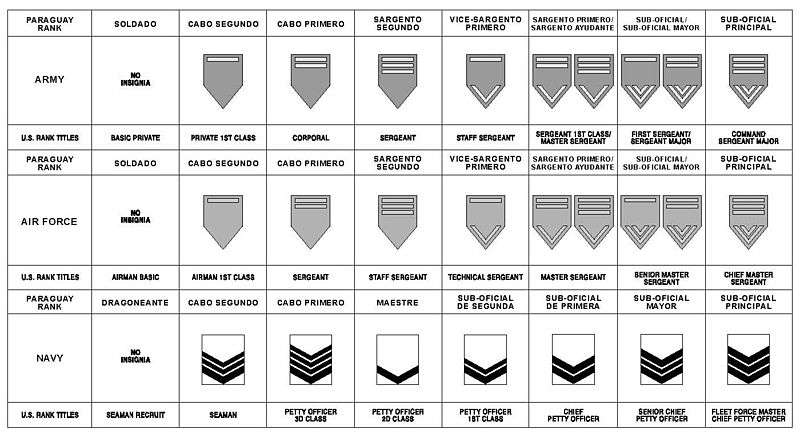
Citations
- "CIA World Fact Book "Paraguay"". cia.gov. 2015. Retrieved 7 June 2015.
- IISS (2012), p. 398
- "U.S. Military Moves in Paraguay Rattle Regional Relations". International Relations Center. December 14, 2005. Archived from the original on 2007-06-12. Retrieved 26 October 2006.
- US Marines put a foot in Paraguay, El Clarín, September 9, 2005 (in Spanish)
- "World Air Forces 2020". Flightglobal Insight. 2020. Retrieved 1 March 2020.
- IISS (2012), p. 399
- Paraguayan military aviation OrBat
- JSRJ 1976, p. 63.
Bibliography
- International Institute for Strategic Studies (IISS) (2012). The Military Balance 2012. London: IISS. ISSN 0459-7222.
- Ehlers, Hartmut (2004). "The Paraguayan Navy: Past and Present". Warship International. XLI (1): 79–97. ISSN 0043-0374.
- Ehlers, Hartmut (2004). "The Paraguayan Navy: Past and Present, Part II". Warship International. XLI (2): 173–206. ISSN 0043-0374.
- Ehlers, Hartmut (2007). "The Paraguayan Navy: Past and Present, Part III". Warship International. XLIV (2): 183–214. ISSN 0043-0374.
- Joint Services Recognition Journal. London: Ministry of Defence. 1976.



